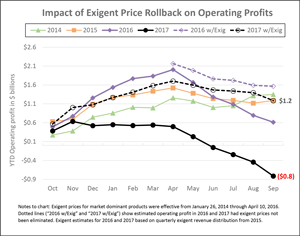News & information
As this graphic shows, without the price rollback the FY 2017 operating profit would be comparable to prior years, as shown by the black dotted line. The purple dotted line reflects a similar adjustment for FY 2016, after the rollback took place in early April. [Click the image to see the full-size version.]
Statement from National Association of Letter Carriers President Fredric Rolando on the release of the U.S. Postal Service’s financial report for Fiscal Year 2017:
Today’s Fiscal Year 2017 financial report shows the underlying business strength of the U.S. Postal Service while also indicating the need to address external matters beyond USPS control.
The operating loss of $800 million reflects the impact of last year’s rollback in stamp prices, which reduces revenue by $2 billion annually. Without the two-cent reduction in stamp prices, Fiscal 2017 would have an operating profit of $1.2 billion.
With the original stamp price, the annual figure would be on a par with those of the past three years, which had a combined operating profit of $3.2 billion (as shown in the chart at right, based on USPS figures). We would be talking about a government entity producing an impressive operating profit through earned revenue. By law, USPS gets no taxpayer money.
The April 2016 rollback in stamp prices was the first since 1919, and it makes little financial sense because the Postal Service already has the industrial world’s lowest rates.
Fortunately, the Postal Regulatory Commission is in the midst of a legally mandated review of the postage rate-setting system. The PRC has said it intends to issue a decision this fall. At present, USPS is constricted in its ability to adjust rates by no more than the Consumer Price Index, but the CPI is an economy-wide measurement of consumer goods and services that doesn’t fit a transportation and delivery provider. The PRC has the ability to correct this mismatch and relieve the resulting financial pressure.
Meanwhile, Congress should address the pre-funding burden it imposed in 2006, which requires USPS—alone among all public and private entities—to pre-fund future retiree healthcare benefits decades into the future. This produces an onerous annual burden of billions of dollars.
Addressing these external financial burdens would allow USPS—which is based in the Constitution and which enjoys broad public and political support—to continue providing Americans and their businesses with the industrial world’s most affordable delivery network.

